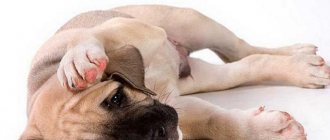The article will discuss the issue of castration or sterilization of a dog. For a long time, dog owners have been arguing about the usefulness of this operation: is it necessary and how humane is it? Many dog owners believe that this procedure can cause psychological trauma in the dog. Others are sure that castration of dogs is simply necessary for the animal. This is precisely the opinion that veterinarians adhere to, often insisting on castration of male dogs, recognizing the operation as safe and useful. This topic has always caused heated discussion; not all owners want to deprive their pet of “manhood.” What does this operation do? Will the dog no longer mate? Is it possible to protect your dog from health problems?
Castration of dogs is an operation during which the testes, gonads, or testicles are removed. As a result, the male dog stops producing testosterone, this is the main hormone that is responsible for sexual desire. The operation is performed surgically. The duration of this action lasts from twenty to forty minutes. Complications are rare.
Castration of a dog - impact on behavior
In the case of dogs, castration eliminates behavior aimed at obtaining a mate: fighting with other males, roaming and marking the area.
Dogs that lunge at other dogs, regardless of their gender, will not change their behavior without proper training, and neither will aggression towards the owner. However, if they attack other potential competitors, castration may be beneficial because it means the aggression is a result of sexual desire.
But sexual behavior is not the only thing that changes after castration. Very often this procedure is performed to eliminate unwanted reactions from the dog. It is believed that after castration, dogs become less aggressive, more tolerant and easier to train.
This effect, however, is increasingly being questioned. Research from 2006 shows something quite the opposite. According to them, from 20 to 50 percent. dogs after castration (both females and males) showed more aggressive behavior than before the procedure. About 30 percent. the animals experienced anxiety, hyperactivity and increased sensitivity to touch.
Interestingly, these changes were observed only in some. While in others, a change in character and behavior was noticed for the better - the dogs became more balanced, emotionally stable and receptive to training. According to experts, this is just proof that castration can have a positive effect on a dog's behavior only if it is accompanied by appropriate training. Therefore, they recommend that behavioral therapy be performed first before deciding to neuter.
At what age can you be neutered?
If you do decide to castrate, it is important to consider the age of the pet. There is no need to carry out the procedure “for prevention” on a small puppy. This can cause growth retardation, insufficient development of the reproductive system, skeleton and muscles.
The very beginning of puberty is considered optimal - from six months to 12 months.
During this period, the pet’s body has already developed, but it has not yet acquired bad habits associated with increased libido.
It is quite normal to castrate an adult, mature male dog. In this case, however, there is a high probability that castration will not help correct the existing stereotypes of behavior of the furry friend. They have already gained a foothold, and good training will be needed to overcome them.
Castration - when to perform the procedure?
The procedure time depends on the breed of the dog. This should happen fairly quickly, shortly after the animal reaches sexual maturity. Small dogs mature quickly, so in their case, castration can be done within a few months; large dogs mature later.
In addition, in the case of large breeds, it is recommended to wait until the dog reaches its final height - hormone deficiency can affect the development of bones and muscle tissue.
If neutering should be done sooner - it is usually recommended for about 3 months after the first fluid, while dogs can undergo this treatment a little later - if there is no need to eliminate aggressive behavior in the male, it can even be the second year of life.
Advantages of castration and sterilization
The operations are worth doing because:
- The pet can be kept in any conditions: apartment, house, yard, enclosure.
- The dog's behavior becomes calmer: males are not aggressive, do not mark territory, do not fight, and females do not run away.
- Prevents diseases of the genital organs (especially cancer) in adulthood.
- Protects against sexually transmitted infections.
- Improves the quality of sleep and appetite.
- Improves mood and desire to play.
- Males striving for leadership gradually lose these habits.
- Will solve problems with the placement of unwanted offspring. Homeless four-legged animals are often operated on for this reason.
Of course, castration will not radically affect the character of your four-legged friend: the need for training, physical activity, and walks remains, but some changes can be noted. The operation does not affect the protective qualities of the pet: if before castration it performed its duties well, this property will remain. Moreover, it is noted that sterilized animals even better guarded their territory. After the operation, bitches show an increase in activity: this is due to the cessation of the production of female sex hormones, which had a calming effect on the psyche.
They operate on animals that are not intended for exhibition and suffer from cryptorchidism. Females not involved in breeding will not produce unwanted offspring.
Principles of dog diet after castration
The main dietary treatment for dogs and bitches after spaying and neutering should be to provide an amount of energy that meets the requirement, but does not activate storage mechanisms for reserve ingredients. Thus, body weight should be monitored and considered central to the prevention of obesity - especially in those breeds that are genetically predisposed to obesity.
There are no ingredients in the diet that are a direct cause of overweight or obesity - only too much of them can lead to such diseases. Each of the nutrients is essential for the proper functioning of the body; a diet devoid of any of them is a deficient diet.
Undoubtedly, the appearance of overweight and obesity contributes to excessive participation in the diet of fats and carbohydrates.
There are many low-calorie diets available on the market, both for losing weight in animals and maintaining their weight after losing weight, so you can always choose the right food for your animal's needs.
Commercial diets for weight loss provide the required amount of all nutrients, but with reduced energy value. Therefore, you should give weight-loss foods no less than your regular daily food, because reducing the dose of such food may cause deficiency of some nutrients (such as proteins).
Important
The earlier castration, the greater the likelihood of its positive effect on the dog's health - it is believed that the procedure performed after the fourth fluid does not protect, but only reduces the risk of developing cancer or ropomacosis. Studies have shown that spaying before first fluid reduces the risk of mammary cancer in female dogs by as much as 95%.
Reasons for castration and sterilization
Castrated females do not attract flocks of males, avoid estrus, which results in the acquisition of unwanted offspring, and reduce the risk of infectious diseases. Castrated males lose excessive aggression, do not mark territory or things, behave calmly on walks, without running after females in heat. Moreover, if females are in heat, males maintain sexual behavior all year round.
Why do they intervene? To avoid:
- Inflammatory diseases of the genital organs.
- The appearance of oncological tumors.
- Preventing estrus and pregnancy in bitches.
Before castrating a male dog, you should carefully consider whether his aggressive, restless behavior is the result of a hormonal surge or a lack of upbringing. If an animal constantly behaves inappropriately with family members or other animals, runs away, or marks its territory, it is worth operating on it. If this is observed from time to time, castration will not fill the gaps in education.
Castration of a dog - negative health consequences
Like any surgical procedure, castration can be dangerous for the animal. Although this type of knitting is now routinely performed in virtually every veterinary practice, the use of anesthesia or surgery always carries the risk of complications. This treatment is not recommended for dogs that have blood clotting problems or have heart disease or cancer.
Neutering can also have a negative impact on your dog's health. One of the diseases caused by the removal of the gonads is urinary incontinence - this most often affects women.
Doctors also note that castrated dogs are more likely to suffer from rupture of the anterior cruciate ligament in the knee joint, hypothyroidism and sarcomas. Castration also promotes prostate tumors in men, as opposed to the diseases it prevents. It is worth noting that these diseases are a more common problem than prostate cancer.
Important
Neutering, for both bitches and dogs, is a way to stop their uncontrolled reproduction. This reduces the number of homeless animals.
Complications and consequences
Castration of a male dog is a simple operation, not abdominal, although it is performed under general anesthesia. Therefore, there is no need to fear the consequences. Within a few hours the pet will feel good. However, as with any operation, the possibility of complications is not completely excluded.
Due to a doctor's oversight, the testes may not be completely removed. What remains unremoved can become inflamed: an abscess may form at the incision site, pus may leak out, and the wound becomes painful.
The pet tries to relieve pain by licking the wound. The dog's body temperature rises, the dog becomes lethargic, refuses to eat, and becomes thirsty.
Refusal to eat
First of all, in this case, a repeat operation is performed, the remains of the testis are removed, the wound is treated again, and a course of antibiotics and local disinfection of the incision are necessarily prescribed.
In addition to the above, if the surgical site is not sterile enough, an infection may enter the wound, resulting in inflammation, and purulent discharge may appear. Inflammation is treated with broad-spectrum antibiotics and local treatment.
Another complication may be suture dehiscence; heavy dogs suffer from this. The culprit in this case may be either the doctor or the owner, who did not take sufficient care of his pet. If the seams come apart, the edges of the wound should be re-sutured, but if the seam has already healed, local treatment is sufficient.
Most often, the owner of the animal is to blame for unwanted complications after surgery - the seam must be monitored and protected from contamination, injury and damage. During the week, walks should be calm, and active games with other dogs should be limited. In rainy weather, you need to take extra time to treat the surgical site.
However, the most difficult consequences of the operation are caused by anesthesia. This could be a general weakened state of the dog, or allergic reactions. Moreover, it is impossible to predict an allergy, as well as to recognize what type of medication and how an allergic reaction will be expressed in each specific dog.
The most complex reactions that threaten the life of a pet are disturbances in the functioning of the lungs and heart. As a rule, young and healthy dogs tolerate anesthesia well, but for old or weakened animals, anesthesia can be fatal.
If, after anesthesia, the dog is breathing heavily or intermittently, the mucous membranes are pale or bluish, convulsions and trembling of the limbs do not go away for more than 20 minutes, you should immediately take the dog to the veterinarian.
Consequences of anesthesia, which are the norm:
- If after surgery the dog “pees.”
- Vomiting (no more than 1 – 2 times).
- Weakness, staggering, uneven gait.
- Slow reactions to voices, frequent blinking.
- Lack of appetite (but not more than 1.5 days).
- Decrease in temperature by 1 degree (during narcotic sleep).
- A slight increase in body temperature during the day after anesthesia.
Lethargic dog
If your dog systematically vomits, has no appetite for more than 2 days, has a fever for more than one day, or has a significant temperature rise (more than 1 degree), you should consult a doctor.
Dog castration - before and after the procedure
Before the procedure, the veterinarian should order basic tests that will allow the dog to qualify for surgery and evaluate whether it is possible to give him anesthesia. These are morphology, heart and kidney tests, etc. In the case of female dogs, the date of castration is important - surgery is best done 3-4 months after fluid intake. The dog must be healthy, and not immediately after vaccination.
Before surgery, the animal cannot eat or drink anything for 24 hours. The castration procedure does not last long, but requires that the dog remain under the supervision of a veterinarian until he awakens from anesthesia. Do not give food or water to your pet for the first hours after treatment. You also have to watch him so that he doesn't scratch his wounds - for this they wear a special straitjacket or collar. The dog will be weakened, so do not take it outside - it is better to let it deal with any physiological needs at home. It is also worth limiting the animal’s activity for several days, and changing the bandage 1-2 days after the procedure.
Preparing for surgery
Preparing for surgery is an important stage, as is postoperative therapy. If there is the slightest doubt, it is worth conducting a diagnosis, taking a general blood test, urine and feces, a biochemical blood test, an ultrasound examination of the internal organs, and an ECG of the heart to make sure the dog can tolerate anesthesia. The veterinarian will conduct an examination and give an opinion on the possibility of surgery. An adult dog must be treated for parasites and dewormed at least a month in advance; the passport must contain notes on the necessary vaccinations. Since castration of a puppy takes place under general anesthesia, it is forbidden to feed the pet on the day of the operation, and it is better to avoid even drinking water for 6 hours.
The owner’s attitude is one of the important factors for a successful operation; Encouraging the dog and being close to it is the key to a successful recovery from anesthesia.
How is castration of a male dog carried out?
Depending on the position of the testicles in male dogs, it is possible to avoid an abdominal incision and remove both testicles from the outside. However, there are also males in which the spermatic cords are separated only after cutting the abdominal cavity. After the testicles are removed, the wound is sutured. After the procedure, your dog will remain connected to monitoring devices until he awakens from the anesthesia.
How is castration surgery performed on a male dog?
In most cases, the castration operation takes 20-30 minutes. To prevent your dog from licking the wound, he should first wear a belly bandage or cone.
Sterilization methods
There are three main methods:
- Endoscopic.
- Chemical.
- Sterilization by laparoscopic method.
Laparoscopic sterilization is one of the modern methods of removing genitals with a mini injection. Its advantages are:
- Greater sterility.
- Anesthesia is provided by inhalation, so the pet immediately recovers from anesthesia.
- No incisions, no pain for the dog.
- There are no stitches, so there is no need to change bandages, wash or treat the wound.
- No need to take antibiotics.











